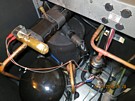
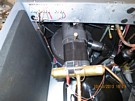
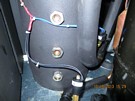
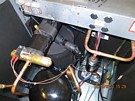
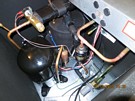
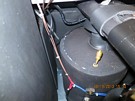
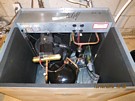
Last Updated: 22-DEC-2021
As we approach the 18 year mark with these systems, I continue to have mixed feelings with them. Up until the major Freon leaks, I believed that it saves money over conventional air-sourced systems. But, how much I am not sure. I continue to have projects that I super-insulate the house (closed cell spray foam) in many places as well as radiant systems in the attic. I have gone far beyond what most people would ever do and the reason is more of a challenge vs. saving $$$. Also, I have installed a 12.5Kw grid tied photovoltaic system in fall of 2019 and planning on doubling it in the near future (2022 or 2023).
The system continues to leak on the upstairs unit and this seems to be increasing. I am now on my second R-22 tank so when that is gone I will replace the upstairs unit.
In the 2018 --> 2021 timeframe, I have called out the HVAC tech 4 times to address leaks (so far), So I have incurred appx $200 a year in costs (plus my freon).
As of DEC-2021, these issue remains - The capacity issue - The first floor system which has two entire floors to deal with will go to auxiliary heat after five days or so in the 20's degree range during the day, and around ten degrees at night. You notice it as you can feel the warmth from it as it's running the strip heaters in the air handler. I assume it just used up all the heat in the ground and that's it. We keep the house at 67 so it's not like we are heating to excess. My solution is to shut it off and run a 77K btu pellet furnace until it gets warmer (and the ground warms up). Most people would not have this option, but it works during those couple of times a year when it gets really cold here although winter 20/21 we never got that cold so hopefully 21/22 will be the same way.
In super-insulating the house I have created another issue. Humidity... The upstairs system cools so fast it does not remove enough humidity so I have to run two dehumidifiers (one in each zone) to remove humidity and dump heat into the zone that the AC can then remove. I have given up on this and realize the issue will remain till I replace the system.
In the summer of 2012 I started letting the upstairs heat up each day to 78 - 80 and did not put the system on till 8pm Then I would set it to 74. These systems have good AC capabilities as the ground is cold. Also, doing this may save a good bit of $$$.
My disadvantages continue to be:
EXPENSIVE - complicated - less people can fix them - if it breaks the system is underground so $$$ issues - runs out of heat or cold a few times a year
My advantages are:
It's all inside the house so no snow to clean or fear that someone will take the outside unit for copper (Not that I would have that issue here) - no outside noise - no outside real-estate taken up by unit.
The MAIN REASON we wanted this is to have an INSIDE system. Now that we are retired, eventually we plan on being away from December to March each year and not having an outside air-source system is one less thing to worry about with weather. But, with the current reliability of these units, I am questioning that.
UPDATE 22-DEC-2021
No photo updates. I could probably re-charge the upstairs system myself, but I get Mike from Reliable HVAC Inc. (A northern Maryland Company) to come by and re-charge using my freon. These systems use more freon in heat mode than cool mode so we generally have issues in the fall. 2020 / 2021 we had to add freon. Generally, a very small amount around 1-2 lbs. so it's not leaking much. The last time we discussed replacement systems and looking at a inverter system (very high seer) to replace these systems. We figure we will stay here less than 10 years so it does not make sense to put in another geothermal system. Also, we have limited ground space around the house so may be looking at a split system that we can wall mount on the side of the house so we won't have snow / ice issues. Time will tell.
The basement / first floor system continues to have NO issues at all and has never been opened. We hope that this luck continues.
UPDATE 10-JUL-2018
In the 2015 -> 2018 (so far), I incurred no cost at all with these systems.
UPDATE 12-SEP-2015
This summer has been great with these systems. It's been a cooler than average summer here and keeping the first floor set at 75 all the time and setting the upstairs system to 80 during the day and 74 at night has worked very well. A couple of ideas on how these systems would have been better.
First, I would have made some sort of cap over the copper Freon lines. When you look at the photo (below in the installation of the manifolds), the vertical part then going horizontal again can,t be maintained well with the weight of the ground on it. I am sure I could have made something out of concrete blocks to protect this.
The second change is that I would have installed a 4 inch PVC pipe down into the top of each well (4-5 feet down) I would have then been able to add sand down the 100 ft deep heat exchanger wells as I feel that the sand level has moved down over time. If this is the case I could possibly have a couple of feet of air-space in each well. This is not good for efficiency and to add more sand in the current installation would be a major undertaking. I could have made the caps level with the grass so it would not have interfered with mowing. Also, I would not have had to check this very often.
UPDATE 26-JAN-2014
But, I must say that I am impressed so far this winter (2013 -> 2014). We have had a number of very cold nights and very low high temperatures for the day and these systems are going strong. So far we have not seen the "can't get the heat issues" that cause us to go to emergency heat problems of past years. I keep the systems at 65 and "so far" no issues at all. With a number of friends having problems with their air source heat pumps, this reinforces my decision in getting these systems.
I hope the leak issues are in the past.
I know a considerable part of these systems running well is the continued insulation projects that I have to make the house efficient.
So time will tell.
UPDATE 19-OCT-2013
The same tech returned in late OCT and filled the system up with 14 more lbs of Freon until the middle sight glass floating ball was 1/2 way in the window. This used one of my 30 lb Freon containers which I paid $89 for a number of years ago. That was a good investment. So between these two visits it cost me appx. $1300. Hopefully that is the end of the Freon leaks.
Excellent work. Does not look like anything changed and the accumulator is not the easiest part of this system to access.
UPDATE 05-OCT-2013
The old very well built accumulator. Amazed that this would leak but it did thru the sight glass area.
It will spend some time on the shooting range in the summer of 2014
UPDATE 23-AUG-2013
So we called around and found that Advanced Heating & Cooling LLC in Reisterstown, Maryland located approximately 25 miles south of here wanted to take on the challenge of fixing this system. I was relieved that when I called they actually answered the phone and I had some interesting technical discussions with Rick Gilmore on the past issues with this system and what they figured it would take to fix our problems. Rick called ECR a couple of times and the technician from Advanced was very good and replaced the accumulator in appx. 8 hrs.
This got the system up and running in cool mode. We decided that when we switched to heat they would come back. Heat mode in these units uses more Freon.
We were concerned with the icing up in the air handler in the attic. But, ECR said it's not a concern.
UPDATE 13-AUG-2013
ECR sent us an accumulator (reservoir) at no cost to us. Spent some time calling around to various companies in the area to get a feel on who we wanted to install this.
The reason that I did not want to go with the same people that have been servicing the system was for a couple of reasons. First, they are not easy to reach. I would call and get nobody and then leave messages and they would never call back. If you are running a business today with all the options of reaching a human working at a remote location this in my opinion is a major problem. And second, they never would recommend us to actually fix this. They liked the idea to sell us the Freon instead.
UPDATE 06-JUN-2013 Photos 07-JUL-2013
Yearly checkup. The attic system was 8 lbs. low so, another $584.00 for R22
Because of the loss of refrigerent we have these systems checked each year. The first floor system was down a bit but will be able to go another year. The second floor unit (attic unit) was down 8 lbs. of freon (at $73 a pound). So, at this rate in 11 months we are losing $53 a month or $1.70 in FREON EACH DAY!! So much for the energy savings !
Here is the invoice ( privacy items removed)
Looking at the photos below it's becoming apparent that the leak is on the reservoir as the Freon has oil in it and its staining the insulation on the tank. It's either the vertical line at the top, the port or the seam under the insulation. I believe that this would be a defect in manufacturing vs. an installation defect as this area is not disturbed in installation.
We will be contacting ECR immediately to see what can be done with this 5.5 year old unit.
Reservoir from the top
Reservoir from the side. Oil on the bottom of the unit.
Still looks nice and clean. The basement is kept cool with low humidity
The oil is running down the blue wire making the insulation discolored in the sensor area
Top showing the install date
Model & serial number
UPDATE 23-MAY-2012
Yearly checkup. The attic system was 3 lbs. low and the first floor system is 1.5 lbs. low. So, another $276.00 for R22
UPDATE 06-SEP-2011
Yearly checkup. The attic system was 1 lb. low so, another $42.00 for R22
Anymore we are worried as so far this year the systems have been pretty good, but we know that the situation can change at any moment.
I made some significant improvement to the attic insulation, that made it so the geothermal systems did not have to work so hard.
When we get to that week or two that it's close to 100 each day and only goes to 80 at night the systems had problems keeping up. I was going to buy one of those windowless systems to supplement the A/C but instead decided to go with the attic upgrades. In the end this was the way to go.
Really, this was the first summer we have seen the benefits of the geothermal system. Happy to say that our electric bill went down each month as the attic project continued.
The HVAC company that maintains the systems changed again. They are now called Green Mechanical LLC. They were hard to reach and I had given up and was going to find another company to maintain our systems, but they finally got back to me. Time will tell if they are reliable.
UPDATE 27-JUL-2010
Most days are over 90 and on the 24th of JUL it was pushing 100.
On the 24th, I noticed that the troubled unit shut off. Did my normal troubleshooting and found everything ok (power / control wise). So I called Sam.
In the end we are not sure of what happened. After the unit was shut off, it reset and was fine.
Really starting to have second thoughts on this geothermal system. Should have gone with a high seer air-source. And in the end the upstairs unit may be replaced. Also, since we have casement windows we can't easily use a normal window A/C unit. I am now researching a 10K-14K thru the wall unit. I figure that it will allow us to cool the bedroom and take some of the load off of these fragile systems.
They work great when they work. I live in fear that the other system will fail. Its working harder now that the second system has failed.
UPDATE 07-JUN-2010
Yearly checkup. The attic system was 11 lbs. low so, another $160.00 for R22 (This would cost $803 today)
Well, summer of 2010 is not the same as 2009. Very hot and very high nighttime temps so little rest for the systems. Early June I noticed that the system was not keeping up so I opened it up. The compressor was very hot. Shut it down and called Superior Techs, LLC, which is now Advance Air Solutions. Sam came out and the system was very low (DOWN 11 LBS) on Freon. We were not sure where it was leaking out but suspected somewhere around the reservoir. This unit is ONLY 3 YEARS OLD ! I should have called ECR but because the R-22 was not that expensive we decided to see what would happen over the next year. Total service Cost $235 and all seemed well.
To mitigate the load on the system I now have three attic fans that keep the attic below 110 degrees. Also, I set the system up to 78-80 during the day to minimize load.
The window / siding project finished in late May so we should be dealing with a higher efficiency level.
The attic insulation project continues.
UPDATE 18-SEP-2009
Had no problems at all during the summer of 2009. Granted, the weather was much cooler than normal but the systems had no issues at all. We are in the middle of a major renovation replacing all 40 windows in the house with new high efficiency windows and also replacing all siding and sheathing with house wrap / 1/4 inch insulation and James Hardie concrete fiber siding . Also, the house will now be white which should save on A/C costs. This major project will be done in the fall of 2009.
The attic insulation project will be done over the winter of 2010-2011 and will correct many issues with the efficiency of this house. Will be interesting to see how much it reduces energy costs.
Also, I have been running a dehumidifier in the master bath this summer and that solved the humidity problem on the second floor. I feel that the window / siding / attic project will make it unnecessary to do this in the summer of 2010.
UPDATE 10-JAN-2009
Well, over a year since we had problems so we are keeping our fingers crossed. Made it thru summer with no issues. Winter has not been real cold so far and I continue to super insulate the house to gain the full benefit of the geothermal systems. Its nice to save money, as well as wear on the systems too.
We have had a high humidity issue in the summer on the second floor and I always blamed the HVAC system. I have discovered we have two issues. First not enough insulation in the attic (I am fixing this) and the biggest issue is that no vapor barrier was installed when the house was built. By summer I should have this upgrade finished and it should solve the humidity issue.
UPDATE 31-DEC-2007
it's been well over a month on the new system and so far no problems. It sounds different than the old one so it took me some time to become used to the difference in the starting / running of the unit. We had a few nights in December where we were below 10 degrees and I saw no problems with it keeping up with the heat loss of the house. As I have said before, I will run the pellet furnace if we have number of days in a row of below normal temps.
ECR: As we have said before, really came through on this. They stood behind their products 110% as this issue was not all their fault. Yes, the first unit had a leak in the reservoir and the entire unit should have been replaced, but Hoffman was at fault in not fixing it right. Hoffman, because of issues they had with ECR, replaced the compressor with a new one that was not even made to run in a geothermal system. I am amazed that it worked as long as it did.
Again, ECR was easy to deal with and fixed this problem at NO COST to us !!
Photos of the new system. In Heat mode. Ice on the freon reservoir.
Back of new unit where the cathode connections caused the freon leak in the previous unit.
Photos of the old system. In Heat mode. Ice on the freon reservoir.
Seeing some rust on various parts of the system.
Back of old unit where the cathode connections caused the freon leak on the other unit.
Considerable amount of rust. This area will be closely watched.
Both units happily humming away keeping us warm !!
UPDATE 14-NOV-2007
Sam returned with the new unit today and the old system was removed.
New system is in, and undergoing nitrogen flood while brazing
Sam had the system back up and running in a few hours.
UPDATE 06-NOV-2007
Sam from Superior Techs, LLC came out to replace the compressor and discovered that we had all the freon leak from where the cathode protection system is isolated from the unit (my guess).
This leak caused the compressor to fail. (I am surprised as I would have figured that the system would have shut down if low on freon, like a car system does)
The compressor got so hot that it started melting the insulation around the freon reservoir.
At this point we found out that the compressor that was installed in 2006 was not even the right one. Hoffman had it in his warehouse and he wanted to get us going no matter what. I am amazed that it lasted a year !!
Sam got on the phone with ECR and they agreed to install a brand new unit to fix this problem ! We are happy to hear this as we have wanted this solution from the first problem.
Looking over the issues with this unit we feel that this was how the problems progressed:
JUN 2006 Freon reservoir leak. Reservoir was replaced. We were told that thay never saw this problem before. Compressor ran low on freon / oil. (Hoffman came out and filled the system up a few times in the couple of months that it was leaking.)
SEP 2006 First compressor was replaced. Probably because of the low freon / oil
OCT 2007 Second (wrong) compressor went bad due to leak ??
Some other views of the dead unit:
Sam said that the new unit should arrive next week.
UPDATE 07-OCT-2007
I noticed that upstairs was warming up and outside temp was in the mid 80's. Investigated the unit in the basement and smelled the classic "something is too hot smell" Pulled lid on unit and top of compressor was too hot to touch. Shut down system and allowed to cool. The next day I restarted unit and it quickly started to overheat. When I used an non-contact IR thermometer, the line to ground quickly got to 200 degrees. Return line from ground was 75. Line to air handler was 58 and line from air handler was 71. Room temp was 68. The top of the compressor was quickly heating up into the upper 90's
This compressor was replaced on AUG 02 2006. This problem is exactly what we went thru the summer of 2006 when compressor had to be replaced !!
We contacted ECR and they were VERY helpful in resolving this problem. ECR is sending a new compressor to Superior Techs, LLC
Now that Hoffman Mechnical is gone, the new company in the area (Superior Techs, LLC) has been very busy with Hoffmans installs.
UPDATE 20-MAY-2007
System is 100% and gave us no problems at all over winter and a few days of A/C so far in 2007. Some day I will put in the adventures with Hoffman Mechnical and how they over DOUBLE charge for supplies.
UPDATE 29-AUG-2006
Again, time is a issue as I have a number of home projects going on. But, we had a compressor failure on the unit that had the reservoir leak (2nd floor system). The latest problem started with thermal issues that were getting worse and worse. Will update the rest of the story when I have the time.
UPDATE 03-JUN-2006
I have not had the time to update on the adventures on the system. Hoffman came out and replaced the thermostat wiring and put another new thermostat on the downstairs unit and now it works fine. Has not gone into AC while in heat mode since.
On the upstairs unit, the freon reservoir had a leak. They replaced the reservoir (following all procedures of pulling a vacuum) and that unit is fine. So, after 15 months we are happy with the systems. As as usual this was the first time that they have seen this sort of problem. So, it was repaired at no cost to me.
We are definitely seeing savings !! My calculations on energy usage was thrown off as we had a foot valve in the well that was making the well pump run many hours per day. So, that was using over $150 a month in extra electricity. Now that its fixed we are happy to see below $100 a month bills.
UPDATE 26-DEC-2005
Still dealing with a thermostat issue. They came out and it worked fine for a few weeks. Then it would not switch to heat from A/C. I have to open up the unit and remove a wire to allow it to switch. Hoffman is coming out to replace the T-stat and the wiring. Besides that no problems. Since I have the strip heaters (AUX) heat disconnected on both units it has to rely on geothermal for all heating needs. One night with 11 degree temps and high winds the downstairs unit 2.5 ton heating 2 floors could not reach the requested 68 degree temp. It was maintaining 66 so I turned on a kerosene heater in the basement to give the unit a additional 23K btu. This only happens when its cold / windy and we have had a number of days of below 25 degree weather. This does not happen too may times in SE PA.
On January 8th I will get the final 2005 electric bill and should be able to figure out the true savings comparing 2005 to 2004.
UPDATE SEPT-2005
A quick update. Yes, its has saved us money. We had a hot summer and compared to last year we figure that we have saved appx. $100 a month in electric. This winter the savings will be greater with the rising cost of LP.
Was it worth it. Still not sure. Its nice not having that loud unit(s) running 24 hrs a day but is that worth the extra $11K over a air source system ??? Time will tell.
I won't know till the end of the year on the total electric savings as Met-Ed likes to estimate the bill every other month so I am never sure what I am using month to month. I have resorted to reading my own meter so I know that the base bill with no geothermal is appx. $120 a month.
Update APRIL-2005
Well, its been 3 full months with the geothermal system installed. For the most part its been great. They are quiet and really produce good heat. I am looking forward to the summer AC season as this should give us the best savings so far. But, a few problems have been encountered.
The biggest.... Going from a house that our primary heat was a pellet furnace on the basement / first floor we increased the electrical draw a great deal when its real cold / windy out. So, one 3.4 degree morning the draw of the two geo systems (2.5 ton is 7.9 amps at 240v and the 3 ton is 9.2 amps) AND the auxiliary heaters were kicking on drawing in the upper 40 amps EACH as well as two electric water heaters running and all the normal loads of a large home. This load which was close to 220 amps, started melting the 200 amp service QD box that we have. Granted with 200 amp service you should be able to draw 200 PER SIDE... So we were only at 1/2 capacity of the box. When I say melt I mean melt. It was so hot you could not touch it. All this happened while we were at work. I came home to a 40 degree house with no power. In trying to get the house warmed back up, I could not draw more that 35 amps per side so it was an adventure to warm it up. This proved to me that I will keep the pellet furnace as a back up. Nice to have 70K btu furnace that only draws 5 amps at 120v for emergency. Thanks to Brockmyer Electrical in Shrewsbury, PA who came out the next day and replaced the box for a bit over $750, we were back in business. According to them the panel was never installed right in the first place and it was a disaster waiting to happen.
One of the issues that we had was that the systems like to turn on the aux heat all of the time. The attic unit is wired with 220v to the air handler and 220 to the strip heater on separate breakers. So, its easy to disable the aux. heater by hitting the breaker. The downstairs system is 220 to the unit. So the strips are harder to disable. I may wire it separate so I can gain control over it or put a switch on the stage heat in the thermostat.
Between the breaker box problems and the power company estimating the bills, I have yet to see how the power usage differs from last year to this year. I do feel that I have some savings.
After close to a year researching the type of system to replace our 15 year old 3 ton heatpump and 2.5 ton A/C with a propane furnace, we have 2 zones with appx. 4,700 sq ft. counting the basement, but not counting a 22x22 garage, We decided to go with a EarthLinked Technologies Direct Exchange (DX) Geothermal Heat Pump. The advantage of DX systems is that they bury copper in the ground where the freon is in contact with the heat / cool of the earth. AT THE TIME, the water systems use plastic pipe that requires you to tear up the yard more (horizontal systems) and the cost in electricity of running a circulator pump to move the water was a issue.
We were tired of the $250+ a month electric bills in the summer and winter (they would have been 600+ by now in 2013) as well as the rising cost of propane. We did save on the propane as we have a 70,000 btu pellet furnace that would burn an average of 6 tons of pellets each season. This heated the basement and the 1st floor. We would spend around $900 each season and required considerable effort in picking up / transporting and carrying the bags of pellets into the basement each year. Also, the pellets brought considerable dust into the house, as well as daily maintenance in keeping the system running.
The first thing we needed to do was find a contractor that installed these system in this area. We lucked out on that as Hoffman Mechanical, Inc. (As of 2007 out of business for various problems) has installed over 100 of these systems in the Mid-Atlantic area over the past few years. But, in the end they screwed us on the install. More on that later !
After a few false starts due to weather and drill problems, they showed up on 27 Dec.
Click on image to make it larger
The old systems. The pad was broken up because it was too small to be used for a 20Kw Generac liquid-cooled generator, that was installed in JAN 2006.
First I had to dig a 16x10 foot hole 6 feet deep. Say goodby to the nice grass. Borrowed a neighbors commercial-size backhoe for this.
Trench back to the house for the pipes
Then the drill came
The plan is to drill six 100ft deep holes (100 feet per ton) The upstairs system is 3 ton and the 1st floor / basement system is a 2.5 ton. The first five holes were not a problem. We hit water in each of them at appx. 60 feet and solid rock was hit at appx. 20 feet down. On the 6th hole we hit a very hard rock around 60 feet down and then a void. The drill did not like going from hard drilling to nothing and I was surprised that nothing was broken. Then while bringing the sections back up out of the hole it came apart and they had to fetch the bottom part in the hole. The first five took appx. 45 minutes per hole. The last one took over 3 hours.
This looks like a safe place to stand... Ya right...
The 100ft copper tube that is placed in the hole. It comes from the factory with a test pressure of 350psi. The top 20 feet or so is insulated because of the difference in temperature of the lines.
Putting in the copper line--all 100 feet of it
Over 2 tons of kiln dried play sand was poured down the six holes. Also, the rock encountered during drilling made a soft surface to begin working on the four manifolds. Play sand is not a common item in the middle of the winter.
The manifolds brazed up.
Almost ready to bury. Insulated and covering the manifolds with sand.
The two compressors in the basement. These two systems feed the two Trane air handlers (one in basement and one in the attic)
The backyard starting to look normal again
The pellet furnace / past winter pile, and transport. We will not miss this !!!
Because I am preparing for solar I have been auditing the systems.
The air handlers (Trane Variable Speed TWE031) if left on uses appx $21 a month ($252) a year. I now let it come on when it wants to vs. always on. With two zones I was spending over $500 a year just blowing air.
The upstairs system (3.5 ton) I sampled from 04 to 30 JUL 2012. It used 295Kwh during these 26 days. It came out to $1.20 a day with the 81 degree setback. During that time the highest temp was 99 and the lowest was 61. We had 312 cooling degree days during this time and one heating degree day.
The downstairs system (3.0 ton) was sampled from 16 - 30 JUL 2012. We do not set the temp back and it is left at 77 degrees. It used 178 kwh and for 14 days it came out to $1.42 a day. During that time the highest temp was 95 and the lowest was 61. We had 156 cooling degree days during this time and 1 heating degree day.
We also have a Honeywell reverse osmosis humidifier on the downstairs air handler. This is a boil type unit. I must say that it works VERY WELL but, it actually uses more power than the geothermal system. It used 16.81 kwh costing $1.60 in a 24 hr period. This would come out to around $50 a month. So, because of this we only use this during the coldest / driest part of the winter.
I plan on putting my kwh meters on to sample the winter electrical demand when I get a chance.